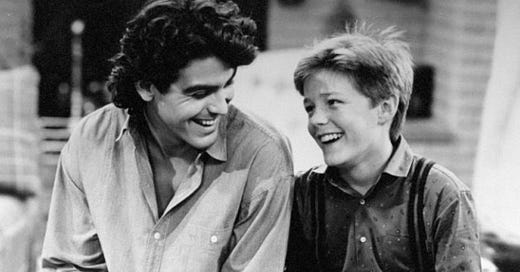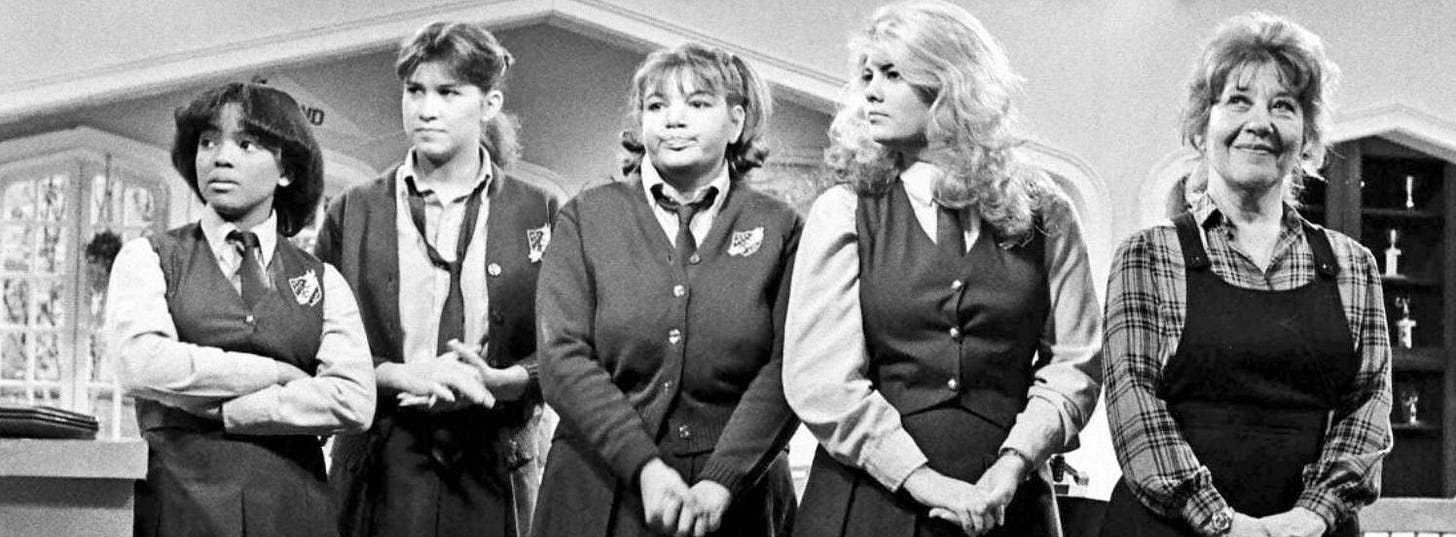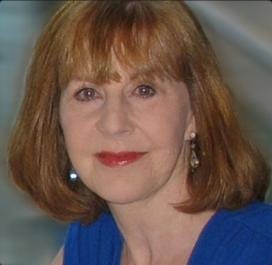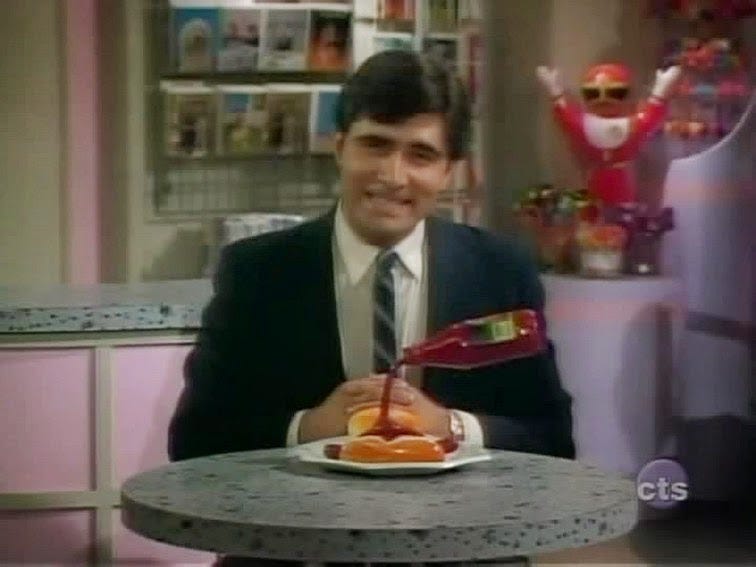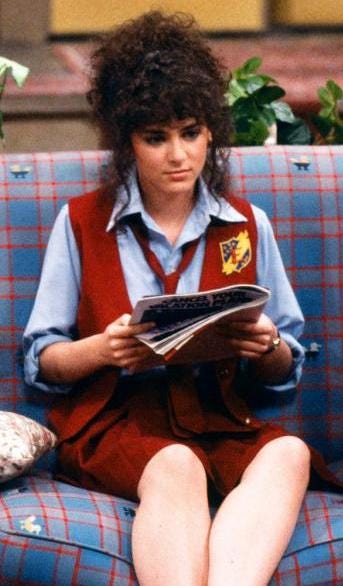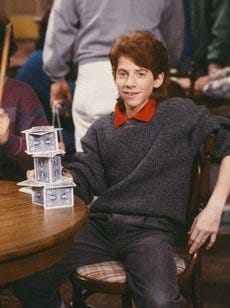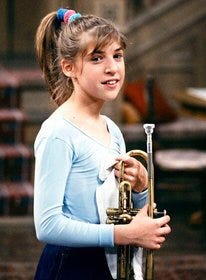Cut for Space: Still more “Facts of Life” anecdotes you haven’t read before
[This post originally appeared on News, Reviews & Interviews (R.I.P.) on February 2, 2016.]
On January 31, 2015, I made my debut on EW.com with “You Take the Good, You Take the Bad: An Oral History of The Facts of Life.”
Now that we’ve passed the one-year mark and there’s no fear of anyone suggesting that I’m stealing readership away from the original piece, I believe I’m standing on solid ground in offering up some of the “deleted scenes,” if you will, from the various interviews I did for the oral history. If you missed Part One, just click here. If you missed Part Two, then just click here. And if you didn’t miss either of ‘em, then let’s roll on!
Mackenzie Astin (Andy Moffett): I’d had a couple of jobs before The Facts of Life, so it was in some respects a standard audition. But my dad (John Astin) had done an episode of the show eight months or so before, and I had visited him on the set briefly. I don’t think that had anything to do with me getting the job, but they were at least slightly familiar with me in some respects because of that. Also, my mom (Patty Duke) had worked with a couple of the folks on the production team – in particular the director, John Bowab – in the not too distant past by the time I came in to audition. But it was still the standard procedure: you go in, you pass the first round, you pass the second round, and then you get to the big auditions, where you go in for the studios and the network. And I got lucky, I suppose.
I don’t know Andy was always supposed to be a long-term character, but I would think so. In retrospect, it seems as though they were trying to add a little younger blood, in that that was the original appeal of the show. By the time I got there, they had been running on all cylinders for six years, and it was a full-fledged successful television show. I think it was one of the top-rated shows on NBC at the time. I don’t know, but it seems like it would’ve been their intention to bring in a younger character because the girls were getting slightly older. It’s funny to say “older” from this perspective, because they were still babies themselves, really. But thankfully I was able to stick around. It took a little while, though. I did four episodes in the sixth season of the show, I think, maybe 10 in the seventh season, and then I was a regular regular in the eighth and ninth.
It was incredible. It was a blast. It was really a terrific, terrific experience. It took me a number of years, I think, to recognize just how gracious they all were to me as an 11-year-old, and then when I was 12 and 13 as a regular, in allowing me into their space and sharing their space. Because that was their space, and it had been established as their space for six years before I was around all the time. I’ve certainly realized it since, though. That dynamic is a powerful one, when people have a successful television show, and when you start adding ingredients to a successful television show, it’s very easy to upset that dynamic. I was very, very fortunate that all the girls were lovely and gracious enough to be accommodating to this young whippersnapper. Although I didn’t recognize it at the time, I’m extremely grateful time for that grace.
Ryan Cassidy and I showed up at the same time – we both did four or five episodes in that first season for us – and then Ryan moved along and George Clooney showed up at the beginning of the next season. At the time, George drove a red Jeep Wrangler. It may have been a CJ-5 or CJ-7, I can’t remember specifically, but there was no top, and it had a fantastic sound system. So anytime I hear the Dire Straits song “Money for Nothing,” I’m immediately back in the parking lot of Sunset Gower, looking at this guy roll up in his red Jeep, top out, and being literally the coolest man on the planet. Like, this is something we all knew back in the middle ‘80s. It took just took the rest of the world awhile to catch up.
The guy was a dream. Everywhere he went, people were in a better mood. He amplified all of our existences. He really made it easier to be where we were, made it more fun, and…he just set a really good example about how one can carry oneself and have a great time while still getting the work done, which I think he continues to do. And not just in the business of show, but outside. He’s had some influence in the political sphere, in terms of setting a good example about how people might do themselves better by behaving.
After The Facts of Life finished, Dad was doing Return of the Killer Tomatoes! down in San Diego, and I went down to visit him and George. It was great to see him, because I was in sort of a transition at that point. I’d gone back to high school to be a so-called normal kid. My mom had been down a lot on her childhood because she was working so much, and I wanted to take the opportunity to not miss out on mine, so I was back in school and having an interesting experience. And I got to spend just a couple of hours hanging out with George, because he was working with Dad, and he continued espouse fantastic advice and have a good time while he was doing it.
I also had an experience with him as a slightly older actor, when George was executive-producing a show for HBO (the pilot Kilroy, which never went to series) and I went in to audition for one of the parts on the show. It was great to see him – we hadn’t seen each other in a few years by that point – and there was a big hug in the audition room before I performed the audition scene, but then I went home and waited to hear. About 4:30 or 5 that afternoon, I got a call from my representatives, who said, “Look, we don’t know anything yet, and we won’t know anything ‘til Monday.” So I said, “Great.” But about an hour later, there was a knock on the door, and it was a messenger delivering an envelope with George’s initials on it. I opened the envelope, and there was a letter from him – handwritten – that said, “Listen, you didn’t get the job, but I wanted you to know now, so you didn’t have to wait through the weekend. It had nothing to do with your acting ability. It was all about your physicality.” Something like that. I think I didn’t have enough muscles or whatever. But the kind of guy who would take the time to write a note and get it delivered by a messenger service late on a Friday afternoon, just to let a guy that he’d worked with before know that he didn’t get the job so he didn’t have to wait all the weekend, is a testament to the kind of class act that that guy is and was and ever shall be. He’s just a classy, classy dude. And a great example for young actors to look to and say, “Wow, that’s how I want to carry myself!” Whether the work comes as much as it has for him, you have no control, in some respects. But to carry oneself like that, that’s really the way to do it.
I have literally described being on that show as being like a kid in a candy store, and once they changed the shop from Edna’s Edibles to Over Our Heads, it actually was a candy store! So being a kid there, it was perfect. I really had a terrific experience. I had interesting, unique relationships with all the gals. I think Mindy and I made each other giggle the most, and I think that actually is still true. But I was lucky enough to pal around with Nancy – she took me to a bunch of Kings games back when they were still in purple and gold – and Lisa and I went to a Jackson Browne concert. That’s pretty fortunate. She drove us in her Maserati, which was so exciting to ride in. And Kim and I were actually in school together for one season, because she’s the youngest of the girls, and she was still I guess in her senior year of high school, so she still had to do three hours of school. So we also had a kinship, I think, because we were slightly closer in age. And we share a birthday!
Charlotte Rae and Cloris Leachman are vastly different people, as are their characters, but Charlotte brought something to the show that I think people still pine for, that sort of mother hen who, no matter how far down the chips were, could always make everything feel all right. And then Cloris was just so zany and interesting and…just nuts! [Laughs.]. She was always so busy with props or with the blocking, and there was always something going on other than what she was saying, and it just added a layer that…well, I think she made us all better actors.
Cloris is amazing. She has an amazing energy, and it is not to be trifled with. I am currently a smoker – I was not a smoker back then – but it became very clear that, if you were a smoker, Cloris would find you, and she would tell you that you shouldn’t be, in no uncertain terms. It was amazing how far away people could be from Cloris while they were having a cigarette and yet she’d still notice and track them down and implore them to knock it right the hell off. She maintains that she’s allergic to them, and that became a very handy way for people to tell smokers that they couldn’t smoke around the show. Before secondhand smoke became a social pariah, labeling one as being allergic to cigarettes was a valuable way to get your point across, but Cloris has been doing it for 35 years. Whether it’s true or not, it doesn’t really matter. You just shouldn’t smoke around her. At all. It’s just in your best interest…and she’ll tell you that it’s in the best interest of everyone else, too! She was just fun. She was fun to be around, and engaged and lively and…crazy! [Laughs.] In the best of ways!
When the show first started, if I remember correctly, it was often heavy on the message. Along with having situations that were comedic, there was a message for many of the episodes. And I think they started to move away from that as the girls got older and the writing staff changed. The writing staff was incredible. You have people on that stuff who are Academy Award winners and Emmy winners now. Martha Williamson was a writer on that staff. Paul Haggis was a writer on that staff. I don’t know if you would have the opportunity to speak with them, but I’m sure their experiences would be interesting to hear. The show was a part of a lot of our youths. [Laughs.] But I think they had the freedom to have a little more fun because the gals got older, and, you know, there’s only so many storylines you can do when you’ve got four girls wearing the uniform of a private school. But as the girls got older and had different jobs and different functions in their characters’ lives, there was more stuff to do, and I think there was more freedom toward the end as a result. That was a ton of fun. I don’t remember anybody ever getting ticked off about one of those kinds of episodes, because they were just so much fun to do.
The Facts of Life Down Under, what a good time. Are you kidding me? “Hey, Mackenzie, you’re 13 years old, we’re gonna take you out of school, and we’re gonna send you to Australia for a month and a half. And you only have to work about two weeks of that month and a half, and we’re gonna give you money to spend while you’re down there. Oh, and by the way, you’re gonna be with a film crew, so everybody’s gonna be excited to see you. And here’s a bunch of good-looking people to surround yourself with!” [Laughs.] Not a bad experience for a young man.
I have considered myself extraordinarily lucky throughout my life, but that experience in Australia was one of the things that really helped hammer it home. I got to see Ayers Rock. I watched the sun set on Ayers Rock, which was an incredible experience. I got to hang out in Sydney and Kings Cross for a little while, which was a lot of fun. It’s a bit like Times Square used to be, and that was spectacular. And I got to hold a koala, for crying out loud! [Laughs.] It was pretty exciting. It was a wonderful, wonderful experience. I, uh, probably got up to a little bit of mischief. Well, no, I did get up plenty of mischief while I was down there…but out of respect for the fella who was my legal guardian, I’m not allowed to disclose that information!
No, I was a pretty good boy during the show. I inherited from my mother a wonderful sense of professionalism, and I inherited from my father a wonderful sense of respect or reverence for the job, so I was always on time, I always knew my lines, and that’s still the number one thing for me. I had plenty of gossipable or unprintable experiences off of the set, away from The Facts of Life, especially after the show ended. I was lucky enough to go through every single one of the things that you see other so-called “child stars” go through, but to do so under the radar. So I was able to gain the knowledge from those experiences, from overcoming those experiences, but without having to have it plastered across the media. Which is lucky.
The weird thing is, I have very little recollection of anything that was shot when I was on the show. And I don’t know if it’s a function of being sort of a heightened experience with a live studio audience or whatnot, or being 30 years in the past, or any number of formerly illegal behaviors that I took part in in the ‘90s. [Laughs.] But I have very little memory of the actual episodes themselves. I remember a lot of stuff around the perimeter and the people I worked with, but the actual shooting of the episodes I have very little recollection of. So watching the episodes now, it’s interesting because it’s like I’m watching it for the first time. I see and hear stuff coming out of my mouth that I don’t remember saying. It’s interesting and bizarre.
I don’t know why (the backdoor pilot for a new Facts of Life series with Blair as the new headmaster of the Eastland School) didn’t go. I’m sure we can be thankful in some respects, because I don’t know if Juliette (Lewis) would’ve been able to get out of her contract in order to get (Robert) DeNiro’s thumb in her mouth! But that was a really talented group. I remember that they were all young enough to have to go to school on set, and for three and a half years, I had been the only guy in the set school, save for a couple of guest actors. So all of a sudden, what had been a one-on-one experience with a fantastic teacher named Reuben Vaughn Greene became poor Reuben trying to corral four or five of the greatest rascals this generation had to offer! It was real interesting to suddenly find myself defending my set teacher from paper airplanes and other high jinks.
I’d only been on the show for about a third of its run (when it ended), so I was still raring to go, and it was an interesting introduction for me to the business of show, because it seemed to me that girl-crazy Andy would be a perfect candidate to attend the co-ed Eastland School. But I found out during the second-to-last episode that I wasn’t in the last episode…and, consequently, wouldn’t be involved in the planned spinoff. And it was a really unfortunate way for me to discover it, because I got the script – they gave out the script to the next episode on the night we taped the preceding episode – and I scanned through it…and there was no Andy! And I thought, “What the heck?” And then it sort of dawned on me that… Well, I still don’t know the reason why, because it seemed to make sense with the context of the story that the character would continue. But the story that takes place on camera is not always the whole story. So it was a very, very abrupt and stark introduction to the business side of show business…and it only took me about 20 years to remember the lyrics to the theme song and get over it. [Laughs.]
Diana Eden (costume designer): The Facts of Life was my very first full-time prime-time television series as a designer. I had been working as an assistant designer for a few years, but a man at NBC had spotted me working, and when Rita Dillon, the producer, was looking for a new designer, he recommended me. So I went in for an interview – I remember it vividly – and, happily, I got the job. So that was the very beginning of my television career: I did the show from 1985 until it ended in 1988.
We didn’t have the (Eastland) uniforms except occasionally, in a flashback or something, so they were in contemporary clothes, so there was a lot of shopping involved and a lot of fittings and try-ons. They all had very unique styles and unique shapes to fit, so it was kind of nonstop. Sitcoms do kind of bend a few rules. The main thing was to make them look as attractive as they could – and I don’t mean that that was a hard task – and so that they felt attractive and fun and colorful. But they each had their unique styles. With Lisa, we obviously had to dress her for her character, which wasn’t the way she dressed personally, so everything was a little more proper, but she had a tiny waist, so that was something that we always liked to show. And she was so charming and appreciative, and I used to get these lovely little thank-you notes from her, especially if she really liked an outfit. That was nice. Nancy had a mind of her own. She was going through kind of a tomboy phase, so she would not wear anything but sneakers at the time. [Laughs.] Reeboks high-tops were the big thing. Kim was the most hip: she really wanted the latest fashion. And then Mindy was just fun-loving, sweet, kind, and had a great sense of humor.
All four of them had completely different bodies, and that was a challenge. In fact, it became a challenge in the third show I designed, when I was still really, really terrified of the whole thing. When they opened their shop, Over Our Heads, the producers said they wanted them all in matching red sweatshirts with the logo “Over Our Heads.” Well, nobody looks good in a sweatshirt. And the girls fought it and fought it and said, “I can’t wear this, I look dumpy, I look horrible.” And I couldn’t personalize. I couldn’t shape one in or make one extra-long. We were just stuck with them. It was quite a battle.
Whenever you have three or four or five women, they each need a particular style. When I started in the sitcom world, we would do a full dress rehearsal at four o’clock, and then there would be notes upstairs, so we’d go up to the meeting room, and I thought the notes would be from maybe the director and one or two producers. But I walked in, and there were, like, 20 people in the room, and about a dozen of them were network. You had to take notes from all levels of producers and network executives, and it was really hard, because they all had opinions, and sometimes they would argue, “Wouldn’t she look better in pink?” Or, “Can you find that dress in turquoise?” And I would sit there wondering, “Who do I listen to? Who’s the top dog?” And eventually it would be filtered down, and we’d make a decision on whether we wanted to change this outfit or if it was really okay and we’ll go with it. So that was a learning curve for me, to have so many people giving opinions on how everything should look.
I don’t cringe (at the ’80s fashions). Let them cringe. [Laughs.] That was what was going on at the time: lots of shoulder pads and leggings and tunics. For me, my challenge wasn’t to be at the height of fashion. It was to have four women or, very often, five women in every scene, which meant I had to make sure they weren’t in the same color, they weren’t in the same style, and…that’s a lot of women to have on camera at one time! And very often, even though it was only a half-hour show, they would have four or five changes, so there could be as many as 20 outfits just for my principals. So it was a little bit of a juggling thing to keep everybody happy. Nancy had her favorite outfits, and so did the others, so you’d hear, “Why can’t I wear blue in this scene?” “Because so-and-so is wearing blue.” That kind of thing.
As a designer for a TV show, I go out and do all the shopping, I know their styles, I know their tastes, I bring in a lot of things, and then we meet in the fitting room. They always had a once-a-week fitting, usually right after the table read, and we’d try things on. I would have selected everything that I wanted them to try on, so in that sense I was making the selection, but then we would fine-tune it with them, and they’d take to one outfit more than another, or something wouldn’t fit as well as something else.
We all got to be a pretty tight-knit family. It was such a routine. By the time I joined the show, the show had been running for six seasons, and it was amazing. We’d be up in the rehearsal hall at the beginning of the week, starting to block it out, and the girls would be hanging out, having coffee or whatever, and the moment John (Bowab), the director, would say, “All right, let’s block this scene,” instantly they’d go into their characters. It was just automatic. They knew who these characters were, they’d been with them for five years, and – boom! – there they were.
George (Clooney’s) wardrobe was really easy. He was the neighbor next door who was a carpenter, so he was in jeans and plaid shirts. Really, all I had to do was to select a bunch of plaid shirts or t-shirts for him. He was just as you’d think he was: he was mellow and charming and laid-back and funny. Of course, we all tease him now, because in all the pictures he’s got this mullet. [Laughs.] It’s a far cry from his elegant look now.
It was a wonderful, wonderful period, because we had the same crew throughout, pretty much, and the same director. I mean, John Bowab, he directed all of the episodes for the later seasons, so we were like family. The stage manager, C.J. “Rapp” Pittman, she was a petite blonde, but she was as strong and tough as you need to be for that job. [Laughs.] And Bob Devicariis, the property manager, he’s another one. We were all family. We celebrated everybody’s birthdays during rehearsal, and the ironic thing was that Kim Fields, Mackenzie Astin, the lighting designer, Don Morgan, and myself all had the same birthday: May 12. Can you imagine? Four people on the show! But we were always on hiatus, so we never got our birthday celebration!
It was such a well-oiled machine. It really was. I can only remember one show where we got halfway through and they pulled the show because it just wasn’t working. It was a show with George where… I don’t know, he came over and he was replacing all of their furniture that he’d made, and somehow the script was not working, and they actually said, “We’re not going to do this one. We’re just going to cancel it and bring up another script.”
When we did Mrs. Garrett’s wedding, we actually postponed the filming, and part of it was my fault, actually, because I was trying to find a wedding look for Charlotte and the four girls that looked like a wedding. I actually designed Charlotte’s dress, because obviously she wasn’t going to be a bride in white, but that was a bit of a challenge, as was what to put the girls in. The producers said, “Well, they must be in bridesmaids’ dresses,” and I said, “Well, I don’t know…” So I bought one set or made them, I can’t remember, and they just all looked awful. I mean, the dresses looked terrible. And I bought another set, which I think were orange lace or something truly awful, and that’s when they said, “We can’t film this wedding.” And we went on hiatus for a week, and I came back and said, “You’ve got to let them all be individual.” So that’s when I went shopping for dresses. They were Matte Jersey dresses, where each of them would have their own style. And even then Nancy refused to wear heels. [Laughs.] She just insisted on wearing flats. And the producers said, “Well, she must wear heels!” And I said, “Well, she’s not going to.” And they said, “Well, we’ll talk to her.” And when they called me back, they said, “Well, I guess she’s going to wear flats!”
It was a really good time. The girls were going through all of their changes, growing up and dating, so it wasn’t always easy. Growing up never is. But all in all we were really a tight-knit family. I used to have all of the girls over for lunch once a year, for about three or four years afterwards, and they’d all come up to the house. Then we had a big 10-year reunion at John Bowab’s house, but I think that was the last of the reunions, because everybody’s kind of gone their separate ways.
Maurice LaMarche (Rod Sperling): As I recall, Meg Liberman, the casting director, knew my work from the Comedy Store, when I used to end my standup act with a Rod Serling impression. She had me in to her office, I read, and next thing I know, I’m at my very first real live sitcom table reading, sitting across from this nice new young actor named George Clooney. I truly had never watched the show at that point. I had met Nancy McKeon in Vancouver doing Alan Thicke’s afternoon talk show for Canadian TV, so there was a feeling of not-total unfamiliarity, but other than her, I had that sense of attending a Thanksgiving dinner at a home where I’d wrangled an invitation because it was just discovered I was a distant cousin.
Plus, I was completely unfamiliar with the dynamics among the characters, and I knew it was a “family” show, so as an “edgy” – or so I thought then – young comic, I was not their target audience. I was not expecting, and was delighted by, the extremely clever script we started with, with lots of in-jokes and sly cultural references, including some great Frau Blucher bits for Cloris. There were big guffaws at the table read, and thank goodness my Serling impression was good enough to garner a few good laughs from those assembled as well. The surprise for me was as the week went on, watching these really clever, funny bits get excised from the script with each rehearsal. “Too hip for the room” was the reason one of the frustrated writers conveyed to me. I thought it was a shame.
In terms of interacting with the cast, though, it was pure delight. Everyone was wonderful. A few of the girls even came down to catch me at the Comedy Store after the second day of rehearsals. I was really honored by that. On the last day, we all went up to… I think it was Nancy’s dressing room, and all the girls, and even George, brought cassette recorders, and I recorded greetings for their answering machines in different voices from my act. Hey, it was the ‘80s: there was no voicemail, let alone iPhones! [Laughs.] I bumped into George in 1999 on the Warner Bros lot, and he remembered that day. He’s a truly nice guy. Unlike George, however, I have not maintained my svelte physique of 1986, so my look has changed a lot. Not to mention, being a voiceover actor, the airwaves are not bombarded with my physical likeness daily…although I daresay a day doesn’t go by when you don’t hear me on your TV or radio. But once in a very great while, someone will actually just come up to me and intone, in their best Rod Serling, “Tootie. I just love saying…Tootie.” I totally love that.
Sherrié Austin(Pippa McKenna): My first audition was over (in Australia), and then they brought us – there were two girls – to the States, and we auditioned again in Hollywood. They just gave me some pages out of an old script. I think I read one of Tootie’s parts from an episode from years prior. I auditioned for the whole network like that. There were, like, 30 people in the room when I came over. And then we went back to Australia, and when they made their decision, I think I moved about six months later, originally with my dad, and then the rest of the family came.
“(Pippa’s constant dropping of Australian slang), it’s authentic dialogue – they actually brought in an Australian writer, Kathy Lette – but it’s just really old-school. It would be like the equivalent of saying things that cowboys would use, so it wouldn’t be anything necessarily that a young girl might use. But if she grew up in the bush, which it’s quite possible Pippa did, and her father was so very Australian, I guess it makes sense that she could pick up some of those things from her dad. My mom, we always refer to her as Crocodile Dundette, because she’s got some brilliant sayings – most of them too dirty for TV – that are really old school Australian, so she knew everything that I was saying in the show. My mom knew all those sayings better than I did.
“Australians are very down-to-earth, laid-back people. I don’t think we really buy into the whole star system quite as much as Americans do, in a lot of ways. And I grew up a very normal kid, y’know? I went to school and climbed trees, and I didn’t grow up in the entertainment business. So it was a very intimidating experience for me, just in the sense that I’d never done it before, but we fit in really well, and my whole family moved over, so I wasn’t alone.
“Cloris Leachman stands out as someone that was really wonderful. The writers were lovely. All the studio people were great. I was very young. I was completely green. Mackenzie was wonderful, too. He became a good support system as well. I remember Cloris taking a million vitamins every day. She had this plastic container with a million vitamins. She’s a health nut. And she didn’t like smoking. But since I absolutely hate smoking, too, I didn’t have a problem with it! [Laughs.] She had more energy than the other four girls put together. She had a great attitude and was just a total pro, but her energy was just amazing. I’ve not been shocked at all that she has continued more than anybody else on the show as an actress. She’s just incredible.”
Seth Green(Adam Brinkerhoff): I don’t know how I ended up in the running for The Facts of Life – I had tested for Diff’rent Strokes, the role that Danny Cooksey did (Sam McKinney), so I don’t know if someone remembered me or what – but once I was in the running, I ended up doing network tests with Jason Naylor, the other guy in the episode, and he and I got to read together, then we got paired up with other people, and…it was just a whole day of network tests.
The day of our first table read, Lisa Whelchel took the new cast out to lunch and was just really kind to us. She told us some fun stories, gave us a couple of warnings, and just put us at ease for anyone who was terrified by this new experience. And we all were, even the ones who had already been working before that, because it was such a big deal. She was just incredibly…kind. That’s just the best word I can think of. She was super generous and present, and she just went out of her way to give information. I can’t speak for anyone else, but it really helped me, at least.
I was disappointed when it wasn’t picked up, sure, but you have to understand: I’ve done a lot of pilots. [Laughs.] So I’m no stranger to the way it works, especially when it comes to ad-sponsored network programming. That’s a very specific game. But I was just excited that I got to do it. It was a really cool experience, and I learned a lot just in those two months.
Mayim Bialik (Jennifer Cole): I have really positive memories of Lisa Whelchel. I think that some of the other cast members were ready to move on with their lives as adults, but the fact that Lisa was interested in continuing the show… She was very friendly, really sweet, and I think she’s a super-talented actress. I remember really respecting her as a comedian.
I was less than a year into professionally acting, and I think that may even have been the first thing I ever tested for, so it was all very new to me. But what I definitely remember is that my Beaches audition was during The Facts of Life. In fact, I specifically remember that I borrowed a red wig from the prop department to take – kind of as a gag – to my first Beaches audition, which was my mom’s idea. But I have pictures of me, actually, on set with that wig. [Laughs.]
And the prop guy who lent me that wig is still in the business! He worked on Conan O’Brien’s show. And when I was on Conan a couple of years ago – his name is John Boyajian– I saw him and remembered him, and I said to him, “You were the one who gave me the wig for my Beaches audition!”

